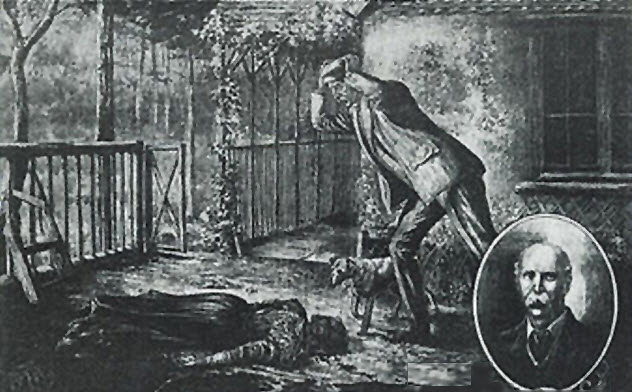 Humans
Humans  Humans
Humans  Animals
Animals 10 Animals That Humiliated and Harmed Historical Leaders
 History
History 10 Most Influential Protests in Modern History
 Creepy
Creepy 10 More Representations of Death from Myth, Legend, and Folktale
 Technology
Technology 10 Scientific Breakthroughs of 2025 That’ll Change Everything
 Our World
Our World 10 Ways Icelandic Culture Makes Other Countries Look Boring
 Misconceptions
Misconceptions 10 Common Misconceptions About the Victorian Era
 Mysteries
Mysteries 10 Strange Unexplained Mysteries of 2025
 Miscellaneous
Miscellaneous 10 of History’s Most Bell-Ringing Finishing Moves
 History
History 10 Great Escapes That Ended Right Back in Captivity
 Humans
Humans 10 Everyday Human Behaviors That Are Actually Survival Instincts
 Animals
Animals 10 Animals That Humiliated and Harmed Historical Leaders
 History
History 10 Most Influential Protests in Modern History
Who's Behind Listverse?

Jamie Frater
Head Editor
Jamie founded Listverse due to an insatiable desire to share fascinating, obscure, and bizarre facts. He has been a guest speaker on numerous national radio and television stations and is a five time published author.
More About Us Creepy
Creepy 10 More Representations of Death from Myth, Legend, and Folktale
 Technology
Technology 10 Scientific Breakthroughs of 2025 That’ll Change Everything
 Our World
Our World 10 Ways Icelandic Culture Makes Other Countries Look Boring
 Misconceptions
Misconceptions 10 Common Misconceptions About the Victorian Era
 Mysteries
Mysteries 10 Strange Unexplained Mysteries of 2025
 Miscellaneous
Miscellaneous 10 of History’s Most Bell-Ringing Finishing Moves
 History
History 10 Great Escapes That Ended Right Back in Captivity
Top 10 Unsolved Mysterious Murders From The Early 1900s
Although most murders are solved relatively quickly, a mysterious few are forever out of reach of the authorities and those who seek justice. While each of these cases could fill volumes in their own right—and some already have—here are 10 times that people literally got away with murder in the early 1900s.
10 The New Orleans Axeman
1918–1919
On the evening of May 22, 1918, Jake and Andrew Maggio made a gruesome discovery. Their dying brother and his already-dead wife had been brutally butchered with an axe. They were the first victims of the person who would become known as the Axeman of New Orleans.
Over the next 18 months, this mysterious murderer took the lives of at least 10 more people in their homes. However, nothing was ever taken from the victims’ dwellings. To this day, the killer’s identity is not known, although there are many theories.
Most of the victims were Italian American, which suggests that the murders may have been motivated by ethnicity or tied to the Mafia and organized crime. Other theories suggest that the killer’s primary goal was to murder women.
Years later, criminologists Colin and Damon Wilson theorized that the Axeman killed male victims only when they obstructed his attempts to murder women. This was supported by cases in which the woman of the household was murdered but not the man, who would have been unaware of the killer’s presence.
According to a more bizarre theory, the killer was looking to promote jazz music. This theory was sparked when the killer allegedly sent a letter to the Times-Picayune stating that he would kill again the following Tuesday (March 19, 1919) at 12:05 AM. However, people who were playing jazz would not be targeted. On March 19, jazz music was played throughout the city and no murders occurred.
The Axeman’s last-known murder occurred on October 27, 1919, when Mike Pepitone was killed in his bedroom. There were several suspects named over the years by people who examined the case. Colin and Damon Wilson believed that the killer was Joseph Momfre, who was shot dead in 1921 by a woman claiming to have been Pepitone’s widow.
However, in a bizarre twist, scholar Richard Warner claimed that the chief suspect in the crimes was Frank “Doc” Mumphrey, a man who had recently moved from New Orleans to Los Angeles and had ties to Mafia families. Mumphrey also used the alias “Leon Joseph Monfre.”
9 The Murder Of Nora Fuller
1902

On January 10, 1902, in San Francisco, 15-year-old Nora Fuller saw an ad in the San Francisco Chronicle looking for a “young girl to take care of baby—good home and good wages.” She spoke with her mother and applied for the position.
The following day, a postcard arrived at the Fuller house instructing Nora to come to the Popular Restaurant for an interview and ask for Mr. John Bennett. Excited, Nora left her house at 5:00 PM for the 6:00 PM appointment. Several hours later, Nora called home to say that Mr. Bennett wanted her to begin work immediately. It was the last time that anyone ever heard from her.
At around 5:00 PM that day, a man who was well-known to the staff of the Popular Restaurant had informed them that he was waiting for a young girl and that they should show her to his table when she arrived. Then he vanished from the restaurant. While all indications are that this person was the Mr. Bennett whom Nora had arranged to meet, it is not known if she ever actually met with him.
On January 16, five days after Nora had left her home, Mrs. Fuller contacted the police to report her missing. Almost three weeks later, Nora’s body was discovered during a company’s routine inspection of its recently vacated property.
Nora’s naked body was sprawled on a bed in an otherwise unfurnished house. Autopsy results showed that she had been strangled to death and probably killed not long after leaving her home almost one month earlier.
The property had been rented to a Mr. Howard, who had signed the lease only two months earlier. Initial police investigations concluded that Howard and Bennett (the man seen at the restaurant) were the same person, although his real identity and whereabouts were unknown.
8 The Halloween Murder Of Walter Schenck
1902

The murder of Walter Schenck was perhaps all the more chilling because it happened on Halloween night 1902. Schenck was a hardworking man who lived with his wife, Ida, and their three young children in the small town of Adair, Iowa. He also served as a city constable, and it was this duty that led to his untimely death.
As Halloween approached, Adair officials anticipated much mischief during the festivities. They decided to deploy their extra constables (including Schenck) to patrol the town during the evening. After eating with his family on Friday, October 31, Schenck left his home to begin his patrol. His wife and children never saw him alive again.
The following morning, his lifeless body was discovered near his own front gate with a single, fatal gunshot wound to the head. A discarded revolver was found nearby. A cartridge had been fired from it, so it was assumed to be the murder weapon.
When Schenck was found, he appeared to have been dead for several hours. The motive seemed to be simple robbery because the cash that he had been carrying the previous evening was gone.
Initial reports speculated that Schenck had taken his own life. However, the disheveled look of his person and the mud on his clothes seemed to suggest that a struggle had taken place and that someone else was responsible for his untimely death.
No one was ever charged or even arrested in connection with the murder. Although investigators had found what they assumed to be the murder weapon, fingerprinting was not used as it is today.
In fact, it wasn’t until the following year (1903) that the New York Police Department and prison service began to compile a database of fingerprints. In 1910, fingerprints were first used as solid evidence in a US court in the Clarence Hiller murder case in Illinois.
7 The Kluxen Woods Murder
1921

On October 6, 1921, a newspaper headline that should have concentrated on baseball’s World Series announced the grim discovery of a murdered 12-year-old girl from Madison, New Jersey, instead.
Janet Lawrence had been stabbed 25 times, and her throat had been slashed. She was found in Kluxen Woods where she often went walking after school. A handkerchief was wrapped around her neck, and her hands and feet were bound with the kind of hemp rope that was normally used to tie rose bushes.
This last clue led investigators to believe that the murderer was likely a greenhouse worker. With no other leads, they began to arrest anyone who may have been even remotely connected to the crime.
Fourteen-year-old Francis Kluxen, who had been shooting in the woods the day that Janet was murdered, was one of the first to be apprehended. Although he had a Boy Scout penknife, there was no blood on his clothing and nothing to suggest that he had been near the area where the body was found. The police were criticized for his arrest, and he was released without charge.
Police then stated that they were looking for a “roughly dressed man” who had been seen in the area. Soon, they arrested Frank Felice, a homeless man. But he was also released quickly without charge.
Next, Frank Ruke was arrested. When he refused to speak with detectives, they took him to the scene of the crime to confront him with his actions. But Ruke refused to look at the spot where the young girl had been found. Despite a struggle with police, Ruke was released a short time later for lack of evidence.
A year later—and still no closer to finding Janet’s killer—the police rearrested Francis Kluxen. This time, he went to trial. On the stand, Kluxen gave a detailed account of his movements that day. A week later, he was acquitted. Once again, the police were heavily criticized for presenting no evidence of Kluxen’s guilt.
The police tried to “railroad” several other innocent men for the murder of Janet Lawrence. But her killer was never caught, and her murder remains unsolved.
6 The Camden Town Murder
1907
The murder of Emily Dimmock in Camden Town on September 11, 1907, captivated the nation. Robert Wood, the man accused of her murder, was defended by the brilliant Edward Marshall Hall, who was quite a celebrity in his day.
Dimmock had recently married railroad worker Bert Shaw, who did not know that his new wife was a notorious prostitute. After her husband left for work in the evenings, she would leave their apartment to ply her trade.
On the morning of September 12, Shaw found the door to their apartment locked. After obtaining a spare key from his landlady, he entered the apartment to find the naked body of his dead wife under a heap of bedclothes on their bed. Her throat had been cut so deeply and precisely that she was almost decapitated.
Shaw had been at work earlier that evening—something that was easily verified—and he was never a suspect. But he soon learned that Dimmock had worked the streets under the name of Phyllis as an accomplished, well-known prostitute.
The list of murder suspects appeared to be long until a signature on a postcard led police to Robert Wood, a local artist who also led a rather seedy alternative existence.
Almost one month later, Wood was arrested and charged with Dimmock’s murder. On the stand, he admitted that he had been with her that evening. But he said that she had been alive when he left her in the Eagle pub shortly after 11:00 PM. Wood was found not guilty of killing Dimmock, and no one else was charged with her murder. Police assumed that Dimmock had been murdered during the night by another client.
As we discussed earlier, Patricia Cornwell suggested in her 2002 book Portrait Of A Killer: Jack The Ripper—Case Closed that this was not the case. She asserted that Dimmock had met up with Walter Sickert, another artist and a regular client of prostitutes.
Sickert became quite obsessed with the murder of Emily Dimmock and painted several pieces entitled The Camden Town Murder after her death. Cornwell drew attention to the similarities to the infamous Ripper murders, including the precise nature of the cut to Dimmock’s throat. However, her theory was not widely accepted.
5 Summerhouse Murder Of Caroline Luard
1908

At around 2:30 PM on August 24, 1908, Caroline Luard and her husband, Major General Charles Luard, left their home in Kent to go on a walk together. General Luard intended to pick up his golf clubs for a trip that he and his wife had planned.
When the couple arrived at Crown Point, they went in different directions. General Luard retrieved his clubs, and Caroline headed to their summerhouse. It was the last time that General Luard would see his wife alive.
By 4:30 PM, General Luard had made his way back home and was beginning to become concerned that his wife wasn’t there yet. They had invited a friend, Mrs. Stuart, to take tea with them, and it was unlike Caroline to be late for company.
General Luard excused himself and made his way to the summerhouse. When he arrived there, he found his wife dead with two bullet wounds to her head.
A police investigation suggested that Caroline had been shot around 3:15 PM in an apparent robbery. Annie Wickham, a housewife who lived nearby, and Daniel Kettle, a farmworker, both told police that they had heard two loud bangs like gunshots at that time of the afternoon.
Although it was proven that General Luard was at the golf course at the time of his wife’s murder, many of the townsfolk considered him to be the prime suspect. He also received numerous threatening and accusatory letters after his wife’s murder. The combination of the letters and two extensive inquiries into his wife’s death began to take its toll on General Luard.
He eventually left his family home and lived for a short time with his friend Colonel Ward. Luard confided to Ward that the pressure of events since his wife’s murder was “unbearable.” Shortly afterward, Luard ventured out to the West Farleigh train junction and threw himself under the express as it passed.
4 The Green Bicycle Murder
1919

The July 5, 1919, murder of 22-year-old Bella Wright (aka the green bicycle case) left the small village of Little Stretton near Leicester, England, in shock. Bella had been shot in the head, and her body was found on the Via Devana by a local farmer at a little past 9:00 PM.
She was last seen alive at 8:50 PM at the house of her uncle, George Measures. She had ridden there on her bike and was accompanied by Robert Light, a man unknown to her uncle and aunt. According to Bella, Light was all but unknown to her, too.
Bella claimed that she had met Light on the road during her journey to see her uncle. Light was riding a green bicycle. He was 34 years old and had drifted through several jobs. He had also served in the army during World War I. But there was something about him that made Bella’s aunt and uncle uneasy.
Whether Bella was truthful in saying that she had met Light for the first time that evening is open to debate. She was in a relationship with Archie Ward, a stoker for the Royal Navy. But she was also involved with at least one other unknown man—“an officer who had a crush on her.”
Although he denied it at the trial, it is possible that Light had been keeping company with Bella before that evening. This theory makes a little more sense when Light’s background is considered. At age 17, he was expelled from Oakham School for “lifting a little girl’s clothing above her head.”
In his early thirties, he had “attempted to make love to a 15-year-old girl.” Despite Light’s admission of additional “improper conduct” toward an eight-year-old girl, no charges were filed against him for these actions.
During his murder trial, Light was defended by acclaimed attorney Edward Marshall Law. He won an acquittal for his client by having Light admit to all charges but the murder—for which there was no proof.
Light admitted to being with Bella that night and to hiding his bicycle to sever the link between him and Bella once he had learned of her death. Light was well-spoken throughout the trial, and his status as an ex–army officer and current teacher seemed to be enough to convince the jury of his innocence.
3 The Locked Room Murder Of Joe Elwell
1920

The murder of Joe Elwell, the leading authority on the card game bridge, remains unsolved. In fact, there has never been a single suspect.
On the morning of June 11, 1920, in busy New York City, Elwell’s housekeeper, Marie Larsen, let herself into his elegant apartment as she normally did. Only on this morning, she was confronted with a sight that temporarily sent the poor woman into shock.
She ran from the apartment, rambling incoherently that there was a stranger in Mr. Elwell’s apartment and that the stranger was dead. Further inspection soon revealed that the dead stranger was Joe Elwell himself, only without the designer wigs and pristine dentures that helped him present a much more eye-pleasing appearance to the outside world.
Elwell had been shot in the head, although suicide was quickly ruled out. There was no sign of the gun in the room, but it appeared that the murder weapon had been fired at Elwell from a distance of about 1–2 meters (3–5 ft).
The previous evening, Elwell had enjoyed dinner at the Ritz-Carlton Hotel with recently divorced Viola Kraus, the latest of many women with whom he was romantically involved.
Elwell had married Helen Derby in 1904. Although Elwell had become a millionaire from his skills at bridge, his wife had been instrumental in introducing him to her well-connected friends and contacts. By 1920, though, they were divorced. At first, Derby was a prime suspect. But her alibi was solid, and it soon became apparent that she wasn’t involved in her ex-husband’s death.
District Attorney Edward Swann believed that Elwell had been sitting in his apartment chatting in the seconds before he was shot and probably knew his killer. It was obvious that the sole intent was murder. No cash or valuables had been taken. In fact, there were plenty of valuables around Elwell’s dead body.
Despite all the evidence amassed by the investigators, they never determined who pulled the trigger and killed Joe Elwell.
2 The Hall-Mills Murder
1922
The morning of September 16, 1922, brought the double murder of Reverend Edward Hall and Eleanor Mills in New Brunswick, New Jersey. Hall had been shot once in the head, but Eleanor had been treated more savagely. Her throat had been cut, and her head was all but taken off her body.
Reverend Hall had been married to Frances Stevens Hall, heiress to the Johnson and Johnson fortune. He had also been having a torrid affair with Eleanor for nearly four years, which had been the gossip of the church community for some time. Eleanor was the wife of Jimmy Mills, the sexton at the same church.
Several love letters from Eleanor to the reverend had been torn up and left around the dead bodies. Obviously, suspicion fell on each of the spouses. However, both Mrs. Hall and Jimmy Mills stated that they knew nothing of the affair.
Both partners claimed that they had last seen their respective spouses at dinner on the evening of September 14. It wasn’t until Jane Gibson (aka “the pig lady”) stepped forward with her account of that evening that Mrs. Hall was placed at the crime scene.
Gibson had been having a problem with corn thieves. When she heard a wagon go through her cornfields on the evening of the murders, she assumed that the thieves were back. She followed the wagon and eventually saw two men and two women in the dark.
She claimed that one of the women shouted, “Explain these letters!” There was the sound of a scuffle, and then a shot rang out. Although Gibson ran away, she could hear a woman scream, “Don’t! Don’t!” Three more shots pierced the otherwise quiet evening.
Despite this statement, the grand jury declined to indict anyone.
Four years later, however, the husband of a former maid at the Hall residence filed a petition to annul his marriage. It stated that his wife had withheld information from him and the police about the Hall-Mills murder.
Public pressure caused the case to be reopened. This time, Mrs. Hall, her two brothers, and her cousin were tried for the murders. However, Jane Gibson, the “pig lady” who was the prosecution’s main witness, was portrayed by the defense as being a “crazy old woman” whose accounts were unreliable.
Ultimately, each of the defendants—despite having a motive for murder—was found not guilty.
1 The Murder Of Willie Starchfield
1914

Willie Starchfield was barely five years old when he was strangled to death and his body was left under a seat in a train compartment. An errand boy made the discovery on the afternoon of January 8, 1914, at Mildmay Park Station on the North London Railway. Markings around the young boy’s neck indicated that he had been strangled with a piece of strong cord.
He was quickly identified as Willie, the son of John and Agnes Starchfield, who were separated. The boy had lived with his mother. Earlier that day, a little before 1:00 PM, she had sent him out to run an errand. It was the last time that she saw him alive.
The coroner’s report placed the time of death somewhere between 2:00 PM and 3:00 PM. As the train undertook several journeys, the boy’s body lay undiscovered until later in the afternoon.
Willie’s father was questioned as to his whereabouts on the day of the murder. But he stated that he had been in bed at a lodging house that day and hadn’t seen his son in three weeks.
A piece of cord had been found on the track by two signalmen on the day of the murder. Meanwhile, another witness stated that he had seen a man in the train compartment “stooping” over something and apparently tying up a parcel.
Perhaps the most important witness, though, was Clara Wood, who identified Willie’s father as having been with his son on the day of the murder. She stated that she had seen John Starchfield leading a young boy along the street. The boy appeared to be eating a piece of cake.
Starchfield sternly denied killing his son but was ultimately charged with his murder. At trial, though, the prosecution’s case collapsed. Wood was an unreliable witness who couldn’t remember key details when questioned. Another potential witness attempted to commit suicide before the start of the trial and was not called to testify.
Worst of all, the coroner read statements to the jury that had been made to the police without formal depositions. This was condemned by the judge, who instructed the jury to find John Starchfield not guilty.
Marcus Lowth is a writer at Me Time For The Mind and Me Time For The Mind on Facebook.








